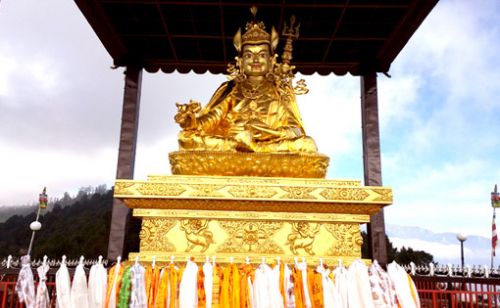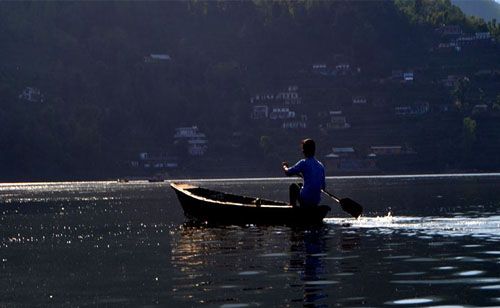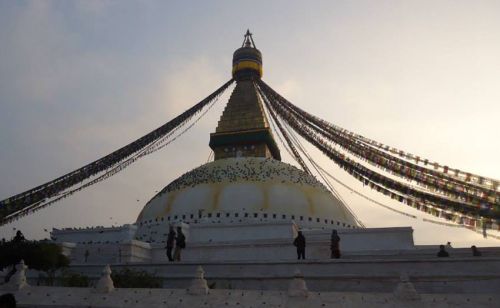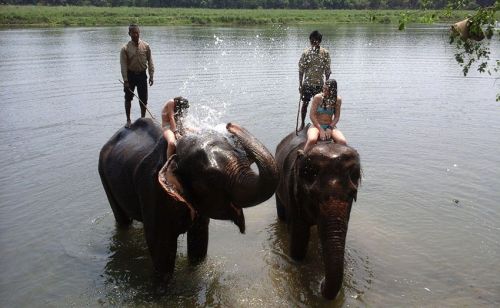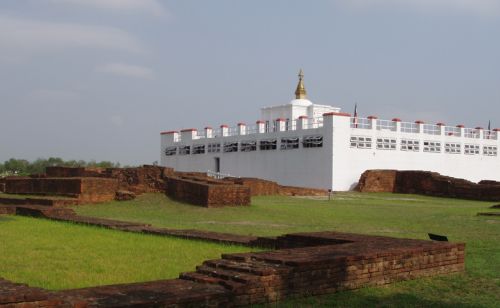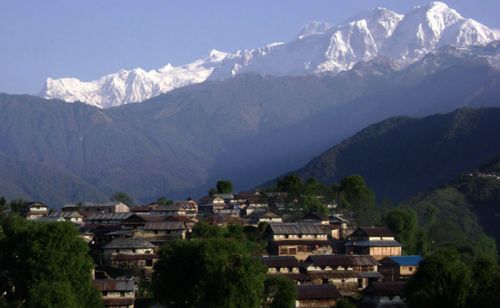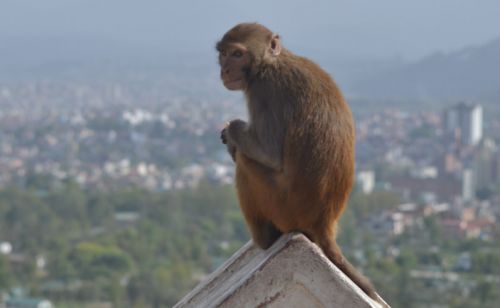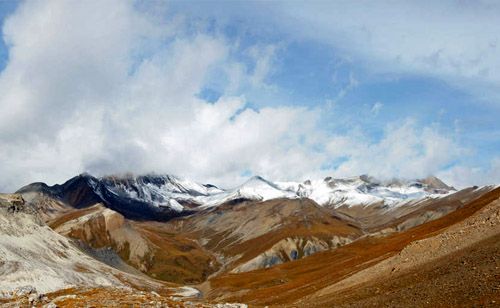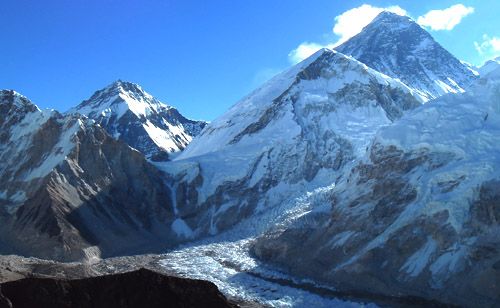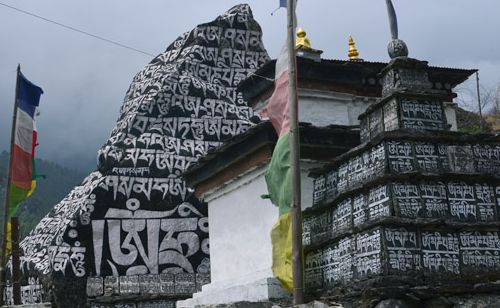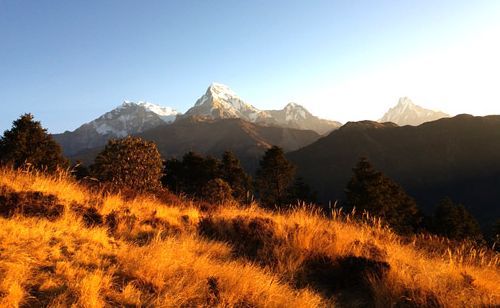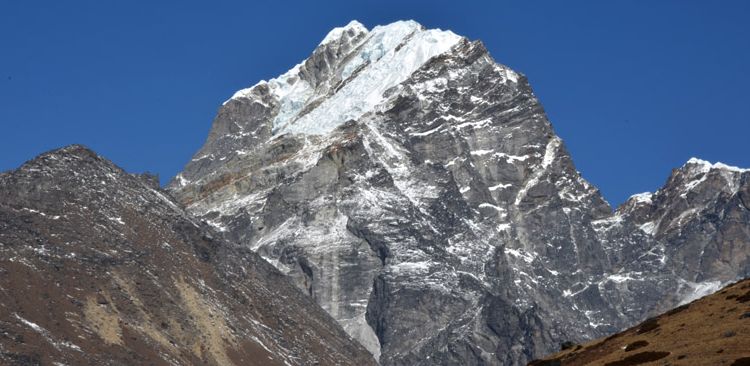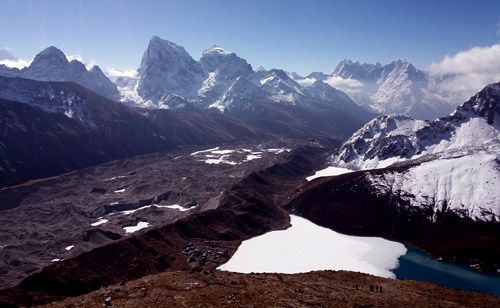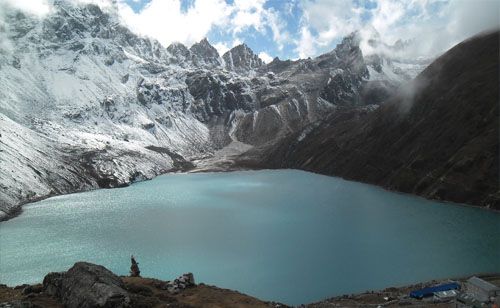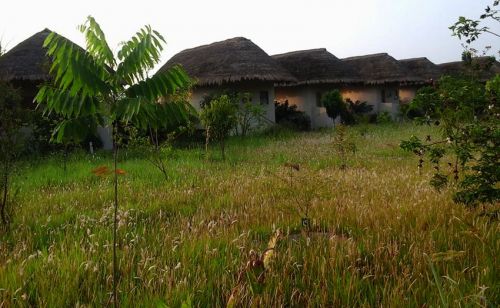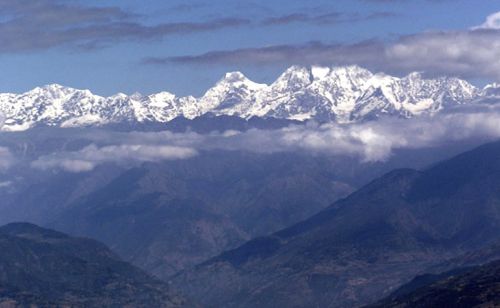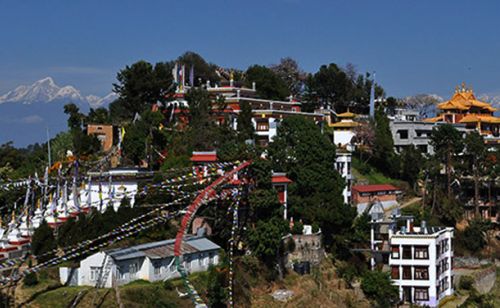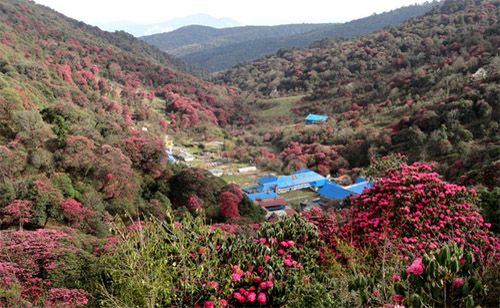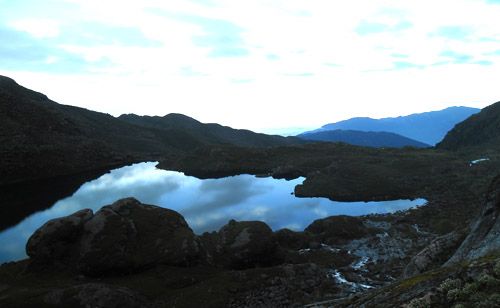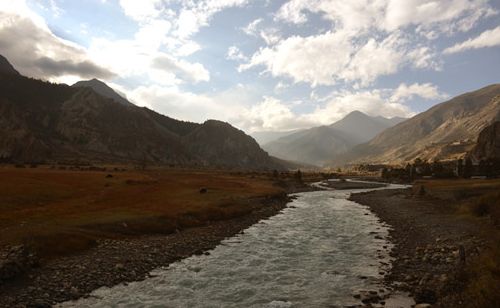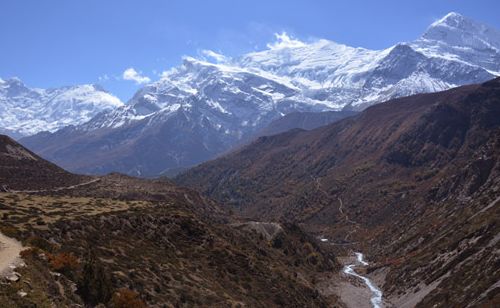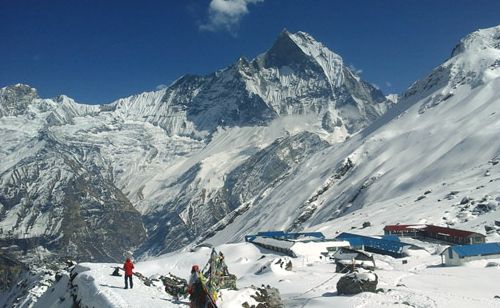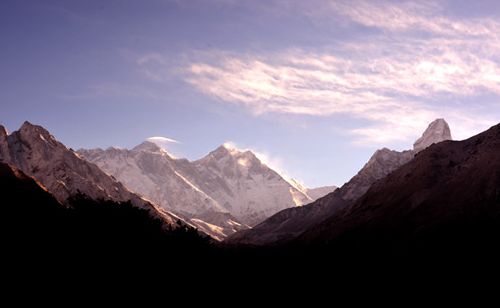The Lobuche peak consists of two different summits, via east and west with heights of 6,119 m and 6,145 m respectively. A continuous ridge connects them but there is still a sharp gap and a considerable distance between them. The east peak is recognized as a trekking peak, whereas the west is known as an Expedition Peak.
Lobuche being an attractive mountain offers various existing routes and also a potential for new ones. The dark triangle of its rocky East face rises over the moraines of the Khumbu Glacier to a spectacular skyline, forming the south ridge.
The peak of Lobuche East is reached by descending a marked notch and climbing steep snowy slopes to the top. On most occasions, the mountain is climbed on the summit ridge only as far as a subsidiary snow summit, southeast of the true peak and before the notch. This peak is identified as the false peak. Laurence Nielson and Ang Gyalzen Sherpa made the first ascent to Lobuche East on 25 April 1984 although there are possibilities that others have reached the summit before. But no records are available. (NMA)
Peak climbing is naturally technical, adventurous and challenging. So, good health and physical fitness is required to climb up the peak. Before you climb the peak you need to be preparing mentally and physical. In Nepal some climbers who come to climb up mountain can’t rich up to their destination because of lack of pre-prepare and planning. If you are well prepared then there is no doubt to get the summit.
Google Map
View on google map
Detail Itinerary
Day 01Arrival at Kathmandu Airport and transfer to hotel along with trek preparation. Overnight at hotel.
Day 02Flight from Kathmandu to Lukla (2840 m) & trek to Phakding (2610 m) about 3/ 4 hrs walk. Overnight at guesthouse.
Day 03Trek from Phakding to Namche Bazaar (3440 m) about 5/ 6 hrs walk. Overnight at guesthouse.
Day 04Acclimatization day at Namche Bazaar.
Day 05Trek from Namche Bazaar to Dole (4110 m) about 6/ 7 hrs walk. Overnight at guesthouse.
Day 06Trek from Dole to Machharmo (4470 m) about 4 hrs walk. Overnight at guesthouse.
Day 07Trek from Machharmo to Gokyo (4800 m) about 4 hrs walk. Overnight at guesthouse.
Day 08Acclimatization day at Gokyo.
Day 09Trek from Gokyo to Thangnag (4700 m) about 3 hrs walk. Overnight at guesthouse.
Day 10Trek from Thakna to Labuche (4910 m) via Cho-la Pass (5420 m) about 8/ 9 hrs walk. Overnight at guesthouse.
Day 11Trek from Labuche to Gorkshep (5180 m) & Everest Base Camp (5364 m) about 6/ 7 hrs walk. Overnight at guesthouse in Gorak Shep..
Day 12Early morning Hike to Kalapatthar (5555 m) & descend to Labuche East Bease Camp (4910 m) about 5/ 6 hrs walk. Overnight at camping.
Day 13Lobuche Base Camp to Lobuche High Camp (5600m) about 3/ 4 hrs walk. Overnight at guesthouse camping.
Day 14Labuche High Camp to Summit Lobuche East (6119 m) & back to Base Camp (5600 m) about 7/ 9 hrs. Overnight at guesthouse camping
Day 15Trek from Lobuche Base Camp to Pangboche (3930 m) about 5/ 6 hrs. Overnight at guesthouse.
Day 16Trek from Pangboche to Namche Bazaar (3440 m) about 5/ 6 hrs. Overnight at guesthouse.
Day 17Trek from Namche Bazaar to Lukla (2840 m) about 6/ 7 hrs. Overnight at a hotel.
Day 18Flight from Lukla to Kathmandu. Overnight at hotel.
Cost Include
-
All additional government tax.
-
Airport picks and drops by private vehicle.
-
2 night hotel in Kathmandu with BB base.
-
Domestic airfare to/ from Kathmandu-Lukla, including airport tax.
-
Meal on full board (breakfast, lunch and dinner) with tea and coffee during trekking.
-
All necessary paper works and national park, trekking & peak permit permits.
-
Accommodation, food, drinks, salary, insurance, transportation of Nepali trekking staff.
-
An experienced government licensed climber guide and porter (1 porter for each trekker& they charge maximum 25 kg).
-
Accommodation at guesthouse with full board during the trekking & +3 nights camping.
Cost Exclude
-
International air fare.
-
Lunch and dinner in Kathmandu.
-
Your travel insurance (Compulsory).
-
Tips to guide, porter and all kind of Drinks.
-
Nepal entry visa fee
-
Your personal trekking & peak climbing equipment
-
Bar bills, telephone bills and other personal expenses (shopping, laundry & shower).
-
All expenses due to sudden events e.g. flight cancellation, personal illness, strike etc.
Approximately Individual Expenditure on the Spot
-
Lunch or dinner in Kathmandu (5- 10 US$) per item
-
Mineral water per bottle (1-3 US$)
-
Hot shower (1-3 US$)
Note: The others expenses are depend on you (shopping, hard drinks, etc.) and situation (flight cancellation, rescue, etc.). If you depart earlier than itinerary program your payment will not be refunded and early arrival expenditure also will not be covered by your trip cost.
Trip Info
Personal Travel Insurance: Travel insurance is easiness in the issues of loss baggage, sickness and accident injury or death most polices cover, we advise to our every client to make your travel insurance during Nepal trip. This includes air ambulance, helicopter rescue, and treatment costs. You should purchase your trip insurance own your country before you book your any trip any Nepal.
Health and fitness: We mainly concern your physical fitness trip in Nepal; our provision is making your trip reliable with wealth health for every tourist. Our first priority is safety for your entire trip. We always make sure for every our staffs to wealth and fitness health before we leave for trip. We have well meditation trained and good experience first aid training staffs. Our crews are very knowledgeable and very familiar with high altitude as team has always prospective and friendly to share each other with our valuable guest. Everyone has government holder trekking guide license with in team. Entire your trip in Nepal some places have not any medical access and pharmacy in Mountain Nepal wide adventure will provide you first aid kits. If you have any medical access own you could bring yours as well.
Accommodation during the Trek: Accommodations for this trek will be sharing a double bed room for two persons sometime you if you are single you get single bed room as well with hygienic food, the lodges are available clean and peaceful. Every trekking routes has fixed menu and hotel system by local management community at in area.
Passport and Visa: Every client must have a veiled passport from return date with at 6 month prior validity in Nepalese consulate in your country or immigration office Tribhuban airport in Kathmandu.
Meals and drinking water: In popular trekking areas like Annapurna, Everest, Langtang and Manaslu have menu system with different ethnic cuisines foods as well as western meals you can see on Menu, you could pick up any kinds of meal as you like from Menu. Some places provide you typical Nepali meals which are different types of international meals. These are prepared by local supplement. Every tourist Lodge has well trained cook basically attention for clean, hygienic, fresh and nice testy foods. We can even enjoy hot chocolates; variety of breads, variety of drinks, and every lodge have safe drinking water or minerals bottles of water you could buy there. If you buy water purification tablet from Kathmandu you can take water from tap and purify by yourself this will be cheaper and controlled to plastic pollution as well.
Trekking equipments: What you should to carry before your departure on your trip.
-
Daypack up to 40 litre,Down Jacket,Seasons sleeping bag
-
Sun head or Gulf cap,Sun glasses,Headlamp or torch light
-
Ear-muffs ,Sun Lotions /Sun cream .
-
1Pair liner gloves thin wool or synthetic.
-
2Cotton t-shirts, 1Synthetic t-shirt.
-
2Long sleeve polyester or synthetic lightweight for sunny days.
-
Zipper provides addition venting options which are good for changing temperatures.
-
1Soft shell jacket water & wind resist.
-
1Women swimming dress bathing in Hot spring.
-
Inner cloths as you need
Lower Body-Legs.
-
1Pair nylon hiking short paints, 1Pair cotton paints.
-
1Pair soft shell pants – synthetic, full zip from top and bottom preferable.
Feet
-
2Pair of loner socks, synthetic, 1Pairs woolen socks wearing on evening and 1Pair light sport shoe.
First Aid Kits:
-
Imodium or Pepto Bismo capsules for upset stomach or diarrheal.
-
Diamox for altitude sickness. Guide will help you to take it.
-
1Small personal sized first-aid kit with blister treatments such as mole skin, bands,Anti-infection ointments, etc.
-
Nepal wide adventure will provide you more medical for trip.
Environment: The Everest National park areas embrace the entire Everest range. Future generations have just as much of a right to appreciate it as we do. This area provides you blooming spectacular view the trails along the lower valleys usually weave through fields. And reaching the upper valley seeing wild animals and excellent Mountain View,
Best Season: High and best season is in autumn (Sept. to Nov.) and second best season is in spring (March to May) for the Annapurna Base Camp Trek. The weather will be sunny and warm with outstanding scenery view. If you wish to avoid crowds this trip during in winter (Dec., Jan. and Feb.) could also be an option to do it.
Acclimatization: Acclimatization is important for the trekking above 3500m. Our trekking schedules have been carefully designed to maximize your ability to acclimatize safely. We ascend slowly and ensure an adequate number of rest days. However, it is still possible for mountain sickness and your tour leader will be watching for symptoms with an experienced eye throughout the trip. These symptoms are commonly headache, nausea, lethargy and sometime breathlessness. If you or any of the group members display any of these symptoms he will be able to provide informed advice and ensure a proper course of action. Your tour leader will advise you more thoroughly regarding the altitude and most of the problems prior to starting on trail.
Equipment List
| Trekking Equipments List
Trekking is simply walking in the hills or the mountains, be it for a day or weeks or more. Certain basic trekking equipment is essential while you're trekking to any parts of the trekking destinations in Nepal. The items may differ from the area to area and on season to season. The following are the list of the equipment that we suggest you for your trekking in Nepal Himalaya.
Clothing:
-
Woolen shirts and thick sweaters.
-
Waterproof jacket with hood or poncho.
-
Sleeping Bag
-
Thermal Underwear and Thermal coat
-
2 pair of loose fitting long shorts/ skirts
-
Light weight walking boots
-
2 pairs of thin socks and 2 pair of woolen socks
Equipment's and Accessories:
-
Snow glasses and sunglasses
-
Trekking Sticks 1 pair.
-
Duffle bag or kit bag to carry to gear while trekking.
-
2-4 plastics bags 2-4 large plastic bags to separate clean clothes from dirty ones. 6-10 smaller plastic bags to dispose garbage.
-
Daypack bag to carry your personal requirements.
-
Water Bottle, water purifying tablets
-
Toilet articles and towels, Toilet paper
-
Umbrella (optional)
-
Headlamp/ torch
-
Binocular, Camera, trekking map and compass, pillow, knife, passport photograph, reading materials, pencil, rubber, pen and notebook, lip guard
-
Toilet papers (we can buy at guesthouse on the trek).
Medical:
-
Small, personal first-aid kit. (simple and light)
-
Aspirin, first-aid tape, and plasters (Band-Aids)
-
1 skin-blister repair kit
-
Anti-diarrhea pills
-
Anti-headache pills
-
Cough and/or cold medicine
-
Anti-altitude sickness pills: Diamox or Acetylzolamide
-
Stomach antibiotic: Ciprofloxacin, etc. Do not bring sleeping pills as they are a respiratory depressant.
-
Water purification tablets or water filter
-
1 set of earplugs
-
Extra pair of prescription glasses, contact lens supplies
Details of Trekking Equipment's:
-
Camp shoes/sandals: A luxury for your feet at the end of the day. Sandals or running shoes will be better you can buy for cheap in Kathmandu.
-
Thermal shirts/underwear: Good thermals, both tops and bottoms are the best for cold weather in trekking.
-
Nightwear thermals: Good for making warm nights in the sleeping bag, Silk-weight is lightest and warm.
-
Fleece/sweatpants: Good for the cold evening and morning.
-
Day-wear T-shirts/ shirts: On the lower altitude trekking weather will be hot, T-shirts and shirts are recommended.
-
Trekking pants: Recommended to have 2 pairs.
-
Windproof & waterproof pants: If your trekking pants are reasonably windproof then special wind pants are not needed. If you do bring a pair, it is not necessary to have Gore-tex. Similar, non-waterproof is quite ok.
-
Underwear: Regular everyday type.
-
Neck gaiter: For winter trekking they are really the best for staying warm.
-
Trekking poles: Trekking poles are very useful especially for downhill, in popular trekking in Nepal you can buy the wooden trekking poles selling by children, trekking can be done without trekking poles also.
-
Sunglasses: Good wraparound glasses suitable for snow, it’s bright up there, but specialized glacier glasses with side pieces are not needed. Contact lens wearers report very few problems except cleaning them in the conditions.
-
Mittens/gloves: A good pair of wind-proof gloves is essential. You can buy in Kathmandu cheap if you don’t have it.
-
Sun hat/woolen hat: Trekking in spring and summer of lower altitude is hotter and whole day sun shining, you can bring the hat or small cap to protect from Sunburn, on the upper part of trek more cold and windy so you can have woolen hat to make your head warmer.
-
First aid kit: All our trekking our tour and trek leaders carry the first aid kit box including the medicine for altitude sickness and diaoheria and other small problems, you should bring any personal medicines that you need, sometime your local medicine is more effective than we provide.
-
Water purification: We can buy the mineral water on the tea house trek. The cost depends on region & altitude. If you don’t buy the mineral water bring the water purification & filter.
-
Water bottle: Two water bottles are recommend 1 liters bottles, bring the good one to take boiling water and be leak proof, European Aluminum bottles are best .
-
Torch / flashlight: Flash light or head lamp is necessary with extra battery.
-
Towel: During the trekking there is no available towel at guest houses so you need one small and light towel for trekking.
-
Sunscreen & lip balm with sunscreen: The sun is strong at altitude, especially after snow. Bring at least sunscreen and lip balm WITH SPF 15, and better still SPF 30+. You can buy in Kathmandu.
-
Moisturizer: The air is dry and windier with dust some part of the trek so moisturizer is good to car for skins. Environmental point of view because of the plastic bottles, hot and boiled water can get from the guest house. Iodine tablets and water purification drop chlorine is recommended to take.
-
Toiletries: shampoo, soap, scissors, hair products, tooth brush and tooth paste, tissues, sun cream, chap stick, antiseptic hand wipes, face washer etc.
-
Daypack: This should be comfortable and a good waist band that transfers some of the weight to the hips is most important. It needs to be big enough to take a jacket, fleece, water, camera and odds and ends. Kathmandu now offers a range of cheap fall-part packs to top of the range.
-
Footwear: One pair of sturdy light to middle-weight hiking boots. Typically these are combination of nylon and leather. We suggest boots with a Gore-tax lining to be waterproof. These types of shoes have a lug sole for good traction and provide lateral support for the ankles that is essential while hiking (for example; the Vasquez Clarion and the A solo Approach). Heavy-weight all-leather backpacking boots are not recommended. Be sure your footwear is broken in and fits well. Boots should fit comfortably over one thin liner sock and a mid-weight wool sock. This reduces chafing and blisters. Tennis shoes or sandals are also useful for in camp use or bathing.
-
Socks: Four pairs of liner socks. Four pairs of mid-weight wool socks. Socks and footwear should be coordinated for a proper fit.
-
Back pack: For travel in Nepal and for trekking a back pack is more suitable than a suit case. If you plan on trekking, hiking a sturdy and comfortable back pack and day pack is essential. You should have your back pack expertly fitted to you before your departure. Your back pack should also have a water proof cover. Normally you need 2 one is 60 litters and another 25 is more suitable.
-
Sleeping bag: Down-filled sleeping bags are better for Nepal tour and trekking. Beg, borrow or steal a good one (i.e. 4-5 season) because high altitude nights will be cold. Good down is fluffy, light and thick. A muff (an extra section around the neck) makes a big difference to the overall warmth of a bag. Reasonable sleeping bags are cheaply available for rent or buy in Kathmandu. We advise you to take -15 is batter.
-
Sleeping bag liner: Cotton, silk or fleece. Saves washing your sleeping bag and adds warmth.
-
Down jacket/Gore-Tex: This jacket is needed for trekking up to 3200m also cold in the evening and morning, if you don’t have it and wanted to use for only Nepal trekking you can rented in Nepal.
-
Fleece jacket: Most trekkers consider this essential, but alternatives are a thick thermal top or a light down jacket. In Kathmandu you can get almost any sort of copy fleece you need.
-
Rain jacket/ wind shell: The jacket should be very water repellent and roomy.
-
Layering: Keeping the proper temperature is best accomplished by adding or taking off layers of clothing. While hiking during the day, you may be in shorts or skirt and a long-sleeved shirt. During the evening, as the temperature cools, you will add a sweater and, perhaps, a parka. Bringing the items outlined below will ensure that you are adequately prepared. Make sure that your clothing is sized to allow your layers and still move comfortably.
|
